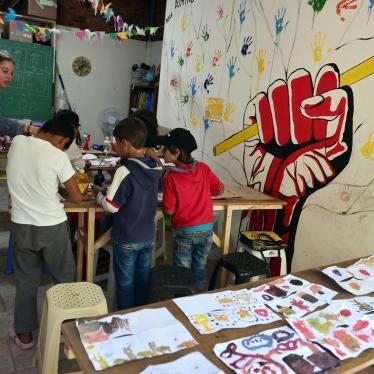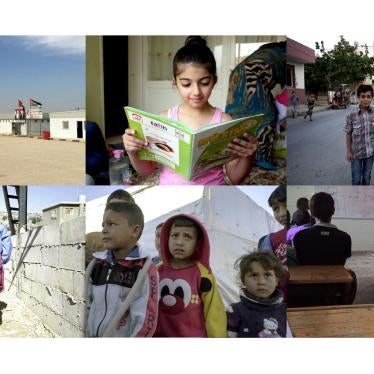(Brussels) – Participants at a conference on Syria in Brussels on April 5, 2017, should address the reasons why more than half a million refugee children are still not in school, Human Rights Watch said today. Donors and host countries had pledged that all Syrian refugee children would be receiving a quality education by the end of this school year.
Donors should be more transparent in reporting the delivery and timing of aid. Host countries should fix bottlenecks, lift restrictions that undermine Syrian children’s access to school, and collect better enrollment data.
“Donors and host countries have promised that Syrian children will not become a lost generation, and yet six years into the crisis, that is exactly what is happening,” said Bill Van Esveld, senior children’s rights researcher at Human Rights Watch. “The governments involved urgently need to fix what’s not working, and to do that they need better information on how many children are in school and on how funding is being delivered.”
In February 2016, at a conference in London, donors and host countries pledged to ensure that all Syrian refugee children in the region were enrolled in school in the 2016-2017 school year. At the time, the United Nations estimated that 715,000 Syrian refugee children ages 5 to 17 were not receiving any education in Turkey, Lebanon, and Jordan. The latest UN estimates indicate that 536,000 Syrian children are still not in school in these countries, which host the largest number of Syrian refugees in the region. Iraq and Egypt also host Syrian refugees.
Donors at the London conference promised to provide annual funding of US$933 million for education in host countries, including US$250 million for Jordan and US$350 million for Lebanon, and to provide enough of that aid before the beginning of the school year for host countries to plan programs and put them into operation.
But Jordan reported that, as of September, its funding shortfall was US$171 million, and it was still US$71 million by the end of December. The funding gap for Lebanon was US$181 million at the start of the school year and US$97 million at the end of 2016. The London conference did not set an aid target for education in Turkey, which budgeted its spending on refugee education at US$1.17 billion in 2016. The European Union alone provided nearly US$690 million to education in Turkey in 2016.
Publicly-available information does not make it possible to assess why the London pledging goals for Jordan and Lebanon were missed. Based on published data, it is extremely difficult to determine how much support individual donors have provided to education in each host country, when they did so, or whether their support targeted key obstacles to education. Donors also pledged to make predictable, multi-year funding available for education, which is needed for planning purposes by host country authorities and independent groups. But only the UK has published clear, accessible information about multi-year funding.
Donor funding will not be enough by itself to abolish the barriers to education in host countries. But clear, timely, accessible, and detailed public reporting of donor funding is needed to show whether aid is addressing key barriers to education for Syrian children, and to effectively press the responsible parties to remove the barriers.
Host countries should lift restrictions and change their own practices that are keeping children out of school, Human Rights Watch said. In Turkey, for example, Syrian refugees can face delays of six months or more to obtain the identification card that is required for children to enroll in public schools.
Restrictions on legal status and work permits exacerbate poverty and increase risks of child labor and early marriage, and leave families unable to afford fees for school transportation and supplies. In Lebanon, donors funded the education ministry to make 200,000 public school spaces available free for Syrian children in 2015-2016, but only 149,000 children actually enrolled. Part of the problem was that many did not have valid residency, for which all Syrians ages 15 and older had to pay a US$200 annual fee. Lebanese authorities formally waived the fee in February for many refugees, but the waiver still excludes a number of the most vulnerable refugees.
Refugee children also drop out due to abuse on the way to school, corporal punishment by school staff, and lack of support to study in an unfamiliar language – Turkish, and in Lebanon, English or French. Some international groups in Turkey and Lebanon have faced bureaucratic obstacles to assigning staff and providing alternative education programs to reach Syrian children.
Host countries also need to collect better and more consistent information about the number of children who are enrolled in and attending school. The lack of this information makes it difficult to assess progress. In Jordan, during the 2016-2017 school year, a government report published in January 2017 stated that “an additional 24,542 Syrian boys and girls were enrolled in formal education, bringing enrolment up to 170,000 students.” But data published in April, compiled through an improved enrollment-tracking system managed by the Jordanian government, found that only 125,000 Syrian children were enrolled in formal education in Jordan in December, and some 40,210 children had no access to education – lower than the estimates published before the London conference. More accurate enrollment data, like those being collected by Jordan’s Education Management Information System (EMIS), are critical for planning and implementing education programs for refugee children.
Host country authorities have compiled enrollment data inconsistently, with various countries using different age groups to compile their data so that it is not comparable. Published figures have not consistently distinguished between formal and non-formal schooling, and often are not broken down by gender or level of education. Secondary-school-age children and children with disabilities suffer from severe barriers to schooling, but enrollment rates for these groups are often not collected or broken down in published data.
“It is still too hard to find answers to basic questions about whether Syrian children are getting an education, and if not, why,” Van Esveld said. “It is crucial that donors and host countries collect the information needed for Syrian children to get into school.”








